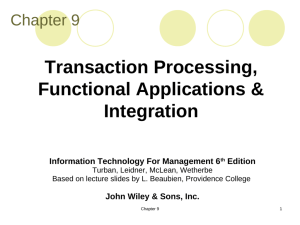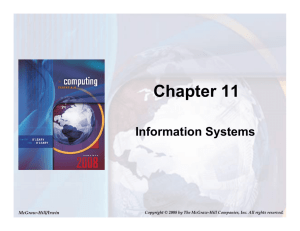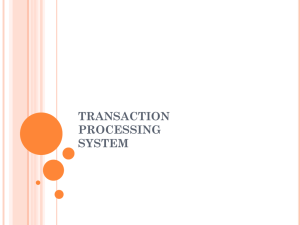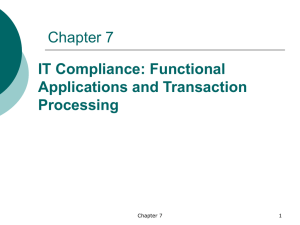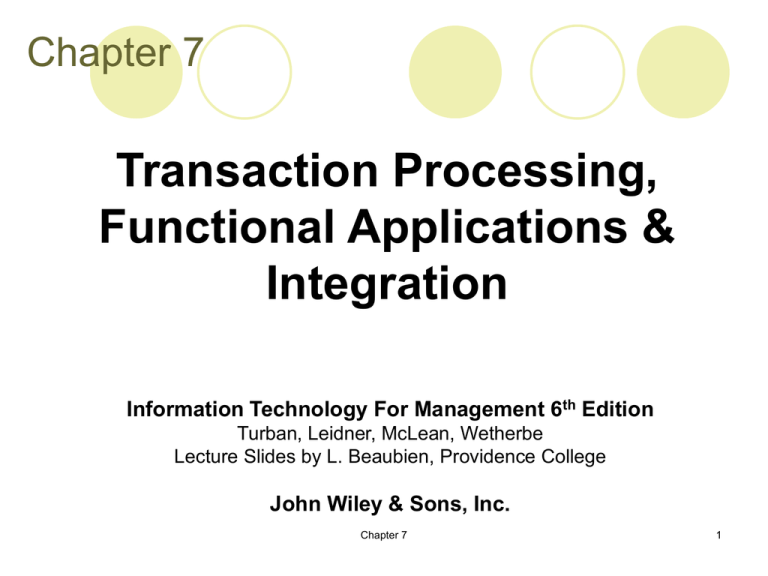
Chapter 7
Transaction Processing,
Functional Applications &
Integration
Information Technology For Management 6th Edition
Turban, Leidner, McLean, Wetherbe
Lecture Slides by L. Beaubien, Providence College
John Wiley & Sons, Inc.
Chapter 7
1
Chapter Objectives
Relate functional areas and business processes to the
value chain model
Identify functional management information systems
Describe the transaction processing system and
demonstrate how it is supported by IT
Describe the support provided by IT and the Web to
production/operations management, including logistics
Chapter 7
2
Chapter Objectives (Continued)
Describe the support provided by IT and the Web to
marketing and sales
Describe the support provided by IT and the Web to
accounting and finance
Describe the support provided by IT and the Web to
human resources management
Describe the benefits and issues of integrating
functional information systems
Chapter 7
3
Functional Areas – Value Chain
Perspective
The value chain model views activities in organizations
as either primary (reflecting the flow of goods and
services) or secondary (supporting the primary
activities). The organizational structure of firms is
intended to support both of these types of activities.
Chapter 7
4
Functional Areas in a Business
Chapter 7
5
Transaction Processing Information
Systems
Chapter 7
6
TPS – Online Transaction Processing Systems
With OLTP and Web technologies such as an extranet,
suppliers can look at the firm’s inventory level or production
schedule in real time. The suppliers themselves, in
partnership with their customers, can then assume
responsibility for inventory management and ordering.
Interactive Internet TPS expands OLTP to provide
enhanced real time transaction processing over the
Internet or intranets. Multi-store chains can access a
centralized computer system no longer requiring in-store
processors.
Chapter 7
7
Managing Production/Operations & Logistics
TPS – Managing Production/Operations &
Logistics
The production and operations management (POM) function in an
organization is responsible for the processes that transform inputs
into useful outputs. In comparison to the other functional areas,
POM is very diversified as are the supporting TPS. It also differs
considerably among organizations.
A few of the IT supported POM areas are:
In-house logistics and materials management
Planning production/operations
Computer-integrated manufacturing (CIM)
Product lifecycle management (PLM)
Automating design work and manufacturing
Chapter 7
8
Managing Production/Operations & Logistics
TPS – Managing Production/Operations & Logistics
Chapter 7
9
Managing Production/Operations & Logistics
TPS – In-House Logistics & Materials Management
Logistics management deals with ordering, purchasing,
inbound logistics (receiving), and outbound logistics
(shipping) activities. These logistical activities cross
several primary and secondary activities on the value
chain.
Inventory management determines how much
inventory to keep. Overstocking can be expensive;
so are understock conditions.
Manufacturing quality-control systems can be
stand-alone systems or part of an enterprise-wide
total quality management (TQM) effort. They
provide information about the quality of incoming
material as well as the quality of work-in-process
and finished goods. Chapter 7
10
Managing Production/Operations & Logistics
TPS – Planning Production/Operations
POM planning is a major component of operational systems
Material Requirements Planning (MRP) is software that facilitates the plan for
purchasing or producing parts, subassemblies, or materials in the case of interdependent
items. It integrates Master Production Schedules, BOM’s, and Inventory levels.
Manufacturing Resource Planning (MRP II) adds functionalities to a regular MRP
system by determining the costs of parts and the associated cash flow. It also estimates
costs of labor, tools, equipment repair, and energy while generating a requirements
report.
Just-in-Time Systems is an approach that attempts to minimize waste of all kinds
(space, labor, materials, energy, etc.) and to continuously improve processes and
systems. The JIT concept is used in mass customization and build-to-order environments.
Project Management. A project is usually a one-time effort composed of many
interrelated activities, costing a substantial amount of money, and lasting for weeks or
years. Software tools such as: program evaluation and review technique (PERT) and the
critical path method (CPM) are used to manage milestones, resources, costs, etc.
Work Management Systems (WMS) automatically manages the prioritization and
distribution of work. These systems deal with resource allocation and reallocation.
Chapter 7
11
Managing Production/Operations & Logistics
TPS – Computer-Integrated Manufacturing
CIM is a concept that promotes the integration of various computerized
factory systems. It has three basic goals: (1) the simplification of all
manufacturing technologies and techniques, (2) automation of as many
of the manufacturing processes as possible, and (3) integration and
coordination of all aspects of design, manufacturing, and related
functions via computer hardware and software.
Typical integrated technologies are:
FMS - Flexible-manufacturing systems
JIT – Just-in-Time
MRP – Materials Requirements Planning
CAD – Computer Aided Design
CAE – Computer Aided Engineering
GT - Group technology
Chapter 7
12
Managing Production/Operations & Logistics
TPS – Computer-Integrated Manufacturing
Chapter 7
13
Managing Production/Operations & Logistics
TPS – Product Lifecycle Management
PLM is a business strategy that enables
manufacturers to control and share product-related
data as part of a products design and development
effort. Web-based supply chains and other
technologies are employed to automate this
collaborative effort.
This electronic-based collaboration can reduce
product cost
travel expenses
costs associated with product-change management
time it takes to get a product to market
Chapter 7
14
Managing Production/Operations & Logistics
TPS – Product Lifecycle Management
Chapter 7
15
Marketing and Sales Systems
TPS – Marketing and Sales Systems
Channel systems are the TPS involved in the process of
getting a product or service to customers and dealing
with their needs. These systems link and transform
marketing, sales, procurement, logistics, and delivery
activities with other corporate functional areas.
Some of the channel-system activities are:
customer relations
distribution channels and in-store innovations
marketing management
telemarketing
Chapter 7
16
Marketing and Sales Systems
TPS – Customer Relations
It is essential for companies to know who their customers are and to
treat them properly. Innovative products and services, successful
promotions, customization, and customer service are a necessity for
most organization.
Customer Profiles and Preference Analysis. Sophisticated information systems are
being developed to collect data on existing and potential customers, their demographics
(age, gender, income level), and preferences.
Prospective Customer Lists and Marketing Databases. All firms need to know and track
who their existing and potential customers are. These prospective-customer lists can be
analyzed and sorted by classification for direct mailing, e-mailing, or telemarketing.
Mass Customization. Today’s customers prefer customized products. Through mass
customization, the practice of maintaining WIP inventory, manufacturers can offer different
product configurations at reasonable prices.
Personalization. Special product offers are made, based on where the customer spent
their time and on what they may have purchased.
Advertising and Promotions. Special promotions or coupons are presented to the
customer via mails, email, wireless and pervasive computing applications.
Chapter 7
17
Marketing and Sales Systems
TPS – Distribution Channels & In-Store Innovations
Organizations can distribute their products and services through a variety
of delivery channels. A company may use its own outlets, mfg.
Representatives, or distributors (to name a few).
IT-Supported Distribution Channels
Internet
Location Based Mapping
Self-service convenience stores
Improving Shopping and Checkout at Retail Stores
Hand-held wireless devices that scan the bar code UPC
Smart card or credit card
Information kiosk enable customers to view catalogs in stores
Self-checkout machines
Check-writers attached to cash registers
Computerization of various activities in retail stores
Video-based systems count and Chapter
track7 shoppers in a physical store
18
Marketing and Sales Systems
TPS – Marketing Management
Many marketing management decision applications are supported by
computerized information systems.
Pricing of Products or Services. Sales volumes are largely determined by the
prices of products or services as is profit.
Salesperson Productivity. Salespeople differ from each other in selling skill.
Sales-force automation increases salesperson productivity by providing them
with mobile devices, access to information, etc.
Profitability Analysis profit contribution of certain products and services can be
derived from cost-accounting systems
Sales Analysis And Trends. Marketing. TPS collect sales figures that can be
searched for trends and relationships.
New Products, Services, and Market Planning. New products and services can
be an expensive risk. “Will it sell?” Requires careful analysis, planning,
forecasting, and market research.
Web-Based Systems support marketing and sales through data capture
Chapter 7
19
TPS – Accounting and Finance Systems
Accounting and finance functional areas manage the inflow and
outflow of organizational assets. This involves all functions of an
organization including payroll, billing, cash management, etc.
Financial Planning and Budgeting
Financial and Economic Forecasting
Planning for Incoming Funds
Budgeting
Capital Budgeting
Managing Financial Transactions
Financial and Economic Forecasting
Planning for Incoming Funds
Budgeting
Chapter 7
Capital Budgeting
20
TPS – Accounting and Finance Systems
(Continued)
E-Commerce Applications of Financial Transactions
Global stock exchanges and multiple currencies
E-Bonds
Factoring online
Electronic re-presentment of checks
Electronic bill presentment and payments
Virtual Close
Expense Management Automation
Investment Management
Financial Analysis
Access to Financial and Economic Reports
Control and Auditing
Budgetary Control and Auditing
Financial Ratio Analysis
Profitability Analysis and Cost Control
Chapter 7
Product Pricing
21
TPS – Human Resources Systems
Web-based systems have increased the popularity of human
resources information systems which provide applications mainly
related to acquiring, hiring, rewarding, developing, training,
protecting and retaining human resources.
Recruitment is finding employees, testing them, and
deciding which ones to hire. The Web has enhanced the
recruitment process.
Position Inventory
HRM Portals and Salary Surveys
Employee Selection
Human Resources Maintenance and Development
Performance Evaluation
Training and Human Resources Development
Chapter 7
22
TPS – Human Resources Systems (Continued)
Human Resources Planning and
Management
Personnel Planning
Labor –Management Negotiations
Payroll and Employees’ Records
Benefits Administration
Employee Relationship Management
Chapter 7
23
Managerial Issues
Integration of functional information systems
Priority of transaction processing
Finding Innovation Applications
Using the Web
Systems Integration
Ethical Issues
Chapter 7
24
Chapter 7
Copyright © 2008 John Wiley & Sons, Inc. All rights reserved. Reproduction or
translation of this work beyond that permitted in Section 117 of the 1976 United
States Copyright Act without the express written permission of the copyright
owner is unlawful. Request for further information should be addressed to the
Permissions Department, John Wiley & Sons, Inc. The purchaser may make
back-up copies for his/her own use only and not for distribution or resale. The
Publisher assumes no responsibility for errors, omissions, or damages, caused
by the use of these programs or from the use of the information contained
herein.
Chapter 7
25

